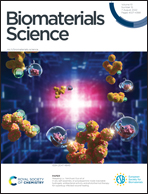Blocking CD47 with restructured peptide nanoparticles for motivating phagocytosis to inhibit tumor progression†
Abstract
Phagocytosis checkpoints, especially targeting CD47, have shown encouraging therapeutic effects. However, there are currently many shortcomings and challenges with immune checkpoint blockades (ICBs). Inspired by the phenomenon of molecular self-assembly, we modify the CD47 targeting peptide (4N1K) onto the self-assembled peptide FY4, as well as the concatenation of PEG at the other terminal via the AZO group to construct hypoxia-responsive nanoparticles (PEG-AZO-FY4-4N1K, PAP NPs), utilizing the peptide as a part of the anti-tumor therapy machine. After degradation, PAP NPs can self-assemble to form fibrous networks and anchor CD47 on the surface of tumor cells, promoting their recognition and phagocytosis by macrophages and relieving immune escape. Self-assembled peptides can interweave on the surface of tumor cells, fully exploiting their morphological advantages to impede normal cell interaction and metastasis. The PAP NPs work synergistically with Doxorubicin (DOX) to further maximize the efficacy of chemoimmunotherapy. In conclusion, this strategy pioneers the progress of self-assembled peptides in biomedicine and promises a novel breakthrough in the development of checkpoint inhibitor therapies.



 Please wait while we load your content...
Please wait while we load your content...